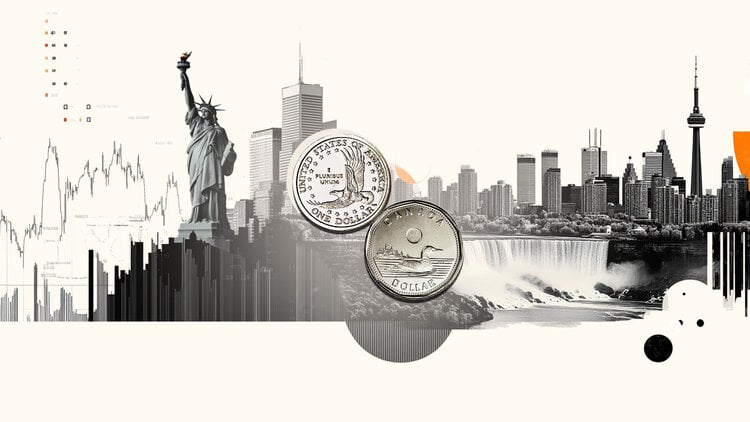- The Aud/USD rises to its highest level since last November as the bullish impulse accumulates.
- The feeling of improved risk continued to support the demand for risk -sensitive currencies, such as the Australian dollar.
- President Trump and the president of the FED, Powell, collide with the rates, generating concerns about the independence of the Fed.
The Australian dollar (AUD) is extending its profits against the US dollar (USD) and reached a maximum in the year to date, since the dollar weakens and improves global appetite due to risk.
At the time of writing, the renovated optimism in the financial markets is supporting the demand for risk -sensitive assets, with the AUD/USD remaining firm above the level of 0.6500 after reaching 0.6564, its highest level since November.
The president of the USA, Donald Trump, has publicly pressed for a faster relief of monetary policy to support growth. Meanwhile, the president of the Federal Reserve (FED), Jerome Powell, has indicated a more cautious approach, citing the need for clearer inflation data.
Although the data of the Personal Consumer Price Index (PCE) on Friday, the preferred inflation measure of the Fed, can provide a clearer image of the latest inflation trends, Powell has argued that the risks representing the tariffs for inflation will probably only be reflected in subsequent reports.
The reluctance of the Fed to cut interest rates has been publicly criticized by Trump, who has already appointed possible candidates to replace Powell, whose official mandate is scheduled to end in May 2026.
The dispute has generated new concerns about the independence of the Central Bank, which has led to a reevaluation of US monetary policy perspectives. This has also turned out that analysts anticipate more aggressive rates cuts in the last quarter of the year, which has pushed down the yields of the US Treasury bonds.
At the same time, a unworthy in the Middle East tensions has reduced the demand for safe refuge flows, promoting risk -sensitive currencies such as the Australian dollar. The favorable raw material trade with China and the stable orientation of the Bank of the Australian Reserve have further supported the Aud/USD.
The AUD/USD proves the wedge resistance while the bulls point to the 0.6600 resistance
The AUD/USD is currently testing the upper limit of an upward wedge pattern in the daily chart, since prices exceed the 61.8% of the fall from September to April, offering immediate support about 0.6550.
The maximum of Thursday at 0.6564 marks the next level of resistance, aligning closely with the resistance of the wedge trend line. A decisive rupture above this area could pave the way for a new test of the key psychological level at 0.6600.
Aud/USD Daily Graph

Beyond that, the bulls can point to the maximum of November at 0.6688, followed by the fibonacci setback of 78.6% in 0.6722.
Despite the bullish tone, the price action remains within the wedge structure, with the support reinforced by the exponential mobile means (EMA) of 50 and 200 days in 0.6455 and 0.6427, respectively. The relative force index in 60 reflects a constant ascending impulse without pointing out overcompra conditions, although a rejection in resistance could trigger a setback towards 0.6500 or a deeper support at 0.6450.
American dollar today
The lower table shows the percentage of US dollar change (USD) compared to the main coins today. US dollar was the strongest currency in front of the euro.
| USD | EUR | GBP | JPY | CAD | Aud | NZD | CHF | |
|---|---|---|---|---|---|---|---|---|
| USD | -0.38% | -0.52% | -0.53% | -0.64% | -0.62% | -0.40% | -0.58% | |
| EUR | 0.38% | -0.08% | -0.20% | -0.23% | -0.20% | -0.01% | -0.18% | |
| GBP | 0.52% | 0.08% | -0.10% | -0.15% | -0.12% | 0.10% | -0.09% | |
| JPY | 0.53% | 0.20% | 0.10% | -0.10% | -0.05% | 0.14% | -0.02% | |
| CAD | 0.64% | 0.23% | 0.15% | 0.10% | 0.04% | 0.15% | 0.06% | |
| Aud | 0.62% | 0.20% | 0.12% | 0.05% | -0.04% | 0.12% | 0.00% | |
| NZD | 0.40% | 0.01% | -0.10% | -0.14% | -0.15% | -0.12% | -0.09% | |
| CHF | 0.58% | 0.18% | 0.09% | 0.02% | -0.06% | -0.00% | 0.09% |
The heat map shows the percentage changes of the main currencies. The base currency is selected from the left column, while the contribution currency is selected in the upper row. For example, if you choose the US dollar of the left column and move along the horizontal line to the Japanese yen, the percentage change shown in the box will represent the USD (base)/JPY (quotation).
US dollar FAQS
The US dollar (USD) is the official currency of the United States of America, and the “de facto” currency of a significant number of other countries where it is in circulation along with local tickets. According to data from 2022, it is the most negotiated currency in the world, with more than 88% of all global currency change operations, which is equivalent to an average of 6.6 billion dollars in daily transactions. After World War II, the USD took over the pound sterling as a world reserve currency.
The most important individual factor that influences the value of the US dollar is monetary policy, which is determined by the Federal Reserve (FED). The Fed has two mandates: to achieve price stability (control inflation) and promote full employment. Its main tool to achieve these two objectives is to adjust interest rates. When prices rise too quickly and inflation exceeds the 2% objective set by the Fed, it rises the types, which favors the price of the dollar. When inflation falls below 2% or the unemployment rate is too high, the Fed can lower interest rates, which weighs on the dollar.
In extreme situations, the Federal Reserve can also print more dollars and promulgate quantitative flexibility (QE). The QE is the process by which the Fed substantially increases the flow of credit in a stuck financial system. It is an unconventional policy measure that is used when the credit has been exhausted because banks do not lend each other (for fear of the default of the counterparts). It is the last resort when it is unlikely that a simple decrease in interest rates will achieve the necessary result. It was the weapon chosen by the Fed to combat the contraction of the credit that occurred during the great financial crisis of 2008. It is that the Fed prints more dollars and uses them to buy bonds of the US government, mainly of financial institutions. Which usually leads to a weakening of the US dollar.
The quantitative hardening (QT) is the reverse process for which the Federal Reserve stops buying bonds from financial institutions and does not reinvote the capital of the wallet values that overcome in new purchases. It is usually positive for the US dollar.
Source: Fx Street
I am Joshua Winder, a senior-level journalist and editor at World Stock Market. I specialize in covering news related to the stock market and economic trends. With more than 8 years of experience in this field, I have become an expert in financial reporting.







